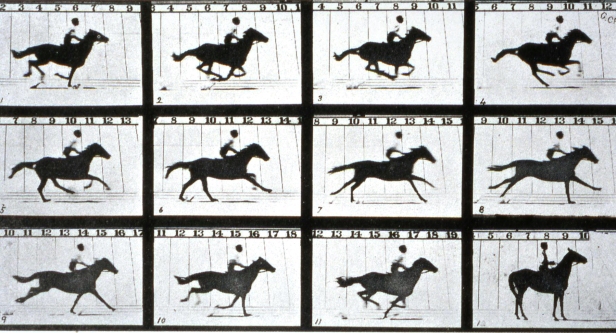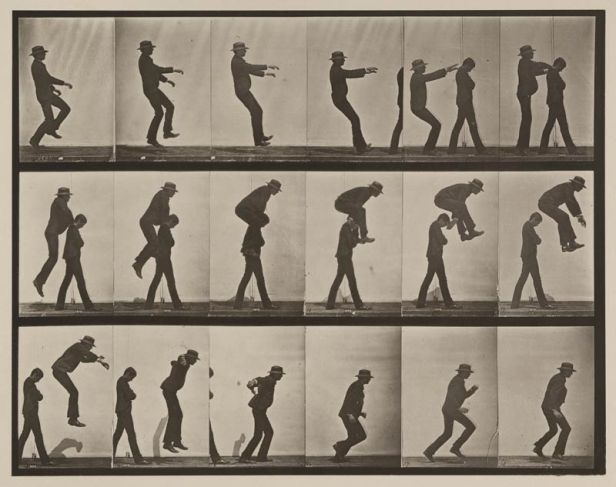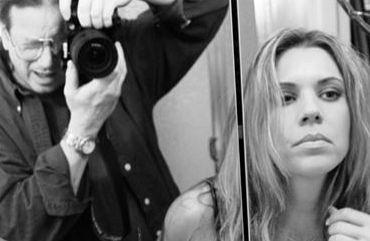[caption id="attachment_5260" align="alignnone" width="616"]

This series of photos by Edward Muybridge proved that all four feet of a horse came off the ground at the same time during a gallop. Credit: Eadweard Muybridge[/caption]
By Bill Dobbins
It is reported that the vision of Leonardo Da Vinci was so acute that he could see almost in stop motion – giving him the ability to make an accurate drawings of the flow of water or birds in flight. But in general that is beyond the ability of most people. We see motion as a blur, like shooting action photos with a slow shutter speed. So until the invention of photography much of the details of what happens with objects in motion was hidden from us.
For example, toward the end of the 19th century there was an ongoing debate as to whether all four feet of a horse came off the ground at the same time during a trot or a gallop. In 1872, the former governor of California, Leland Stanford, a businessman and race-horse owner, wanted to settle this question and he hired Eadweard Muybridge to do some photographic studies. Muybridge experimented with how to achieve this goal and came up with a set-up in which 12 cameras were set up in a row, the shutters triggered as the horse moved past.
[caption id="attachment_5247" align="alignnone" width="616"]

Credit: Eadweard Muybridge[/caption]
[caption id="attachment_5246" align="alignnone" width="616"]

Credit: Eadweard Muybridge[/caption]
Muybridge did not use his methods only to settle a bet about horses. His work involved a range of photos studying and recording animal locomotion in the late 1870s, In the 1880s, Muybridge was associated with the University of Pennsylvania in Philadelphia, and produced over 100,000 images of animals and humans in motion, managing to capture what the human eye could not distinguish as separate movements.
Eadweard Muybridge was also pioneer in the field of motion pictures. He developed a device called the zoopraxiscope which projected a series of photos to create the illusion of motion, predating the invention of the motion picture camera and film.
[caption id="attachment_5268" align="alignnone" width="616"]

Credit: Eadweard Muybridge[/caption]
Muybridge’s Zoopraxiscope system created the illusion of motion before the invention of the movie camera and film.
Surprisingly, Muybridge is also known for his photos of landscapes such as that of
Yosemite taken in 1868 – a subject almost diametrically opposite of action images.
[caption id="attachment_5245" align="alignnone" width="616"]

Credit: Eadweard Muybridge[/caption]
[caption id="attachment_5277" align="alignnone" width="616"]

Credit: Eadweard Muybridge[/caption]
***********************************
Bill Dobbins is a pro photographer located in Los Angeles. He is a veteran photographer and videographer who has exhibited his fine art in two museums and a number of galleries and who has published eight books, including two fine art photo books:
WEBSITES
 This series of photos by Edward Muybridge proved that all four feet of a horse came off the ground at the same time during a gallop. Credit: Eadweard Muybridge[/caption]
By Bill Dobbins
It is reported that the vision of Leonardo Da Vinci was so acute that he could see almost in stop motion – giving him the ability to make an accurate drawings of the flow of water or birds in flight. But in general that is beyond the ability of most people. We see motion as a blur, like shooting action photos with a slow shutter speed. So until the invention of photography much of the details of what happens with objects in motion was hidden from us.
For example, toward the end of the 19th century there was an ongoing debate as to whether all four feet of a horse came off the ground at the same time during a trot or a gallop. In 1872, the former governor of California, Leland Stanford, a businessman and race-horse owner, wanted to settle this question and he hired Eadweard Muybridge to do some photographic studies. Muybridge experimented with how to achieve this goal and came up with a set-up in which 12 cameras were set up in a row, the shutters triggered as the horse moved past.
[caption id="attachment_5247" align="alignnone" width="616"]
This series of photos by Edward Muybridge proved that all four feet of a horse came off the ground at the same time during a gallop. Credit: Eadweard Muybridge[/caption]
By Bill Dobbins
It is reported that the vision of Leonardo Da Vinci was so acute that he could see almost in stop motion – giving him the ability to make an accurate drawings of the flow of water or birds in flight. But in general that is beyond the ability of most people. We see motion as a blur, like shooting action photos with a slow shutter speed. So until the invention of photography much of the details of what happens with objects in motion was hidden from us.
For example, toward the end of the 19th century there was an ongoing debate as to whether all four feet of a horse came off the ground at the same time during a trot or a gallop. In 1872, the former governor of California, Leland Stanford, a businessman and race-horse owner, wanted to settle this question and he hired Eadweard Muybridge to do some photographic studies. Muybridge experimented with how to achieve this goal and came up with a set-up in which 12 cameras were set up in a row, the shutters triggered as the horse moved past.
[caption id="attachment_5247" align="alignnone" width="616"] Credit: Eadweard Muybridge[/caption]
[caption id="attachment_5246" align="alignnone" width="616"]
Credit: Eadweard Muybridge[/caption]
[caption id="attachment_5246" align="alignnone" width="616"] Credit: Eadweard Muybridge[/caption]
Muybridge did not use his methods only to settle a bet about horses. His work involved a range of photos studying and recording animal locomotion in the late 1870s, In the 1880s, Muybridge was associated with the University of Pennsylvania in Philadelphia, and produced over 100,000 images of animals and humans in motion, managing to capture what the human eye could not distinguish as separate movements.
Eadweard Muybridge was also pioneer in the field of motion pictures. He developed a device called the zoopraxiscope which projected a series of photos to create the illusion of motion, predating the invention of the motion picture camera and film.
[caption id="attachment_5268" align="alignnone" width="616"]
Credit: Eadweard Muybridge[/caption]
Muybridge did not use his methods only to settle a bet about horses. His work involved a range of photos studying and recording animal locomotion in the late 1870s, In the 1880s, Muybridge was associated with the University of Pennsylvania in Philadelphia, and produced over 100,000 images of animals and humans in motion, managing to capture what the human eye could not distinguish as separate movements.
Eadweard Muybridge was also pioneer in the field of motion pictures. He developed a device called the zoopraxiscope which projected a series of photos to create the illusion of motion, predating the invention of the motion picture camera and film.
[caption id="attachment_5268" align="alignnone" width="616"] Credit: Eadweard Muybridge[/caption]
Muybridge’s Zoopraxiscope system created the illusion of motion before the invention of the movie camera and film.
Surprisingly, Muybridge is also known for his photos of landscapes such as that of Yosemite taken in 1868 – a subject almost diametrically opposite of action images.
[caption id="attachment_5245" align="alignnone" width="616"]
Credit: Eadweard Muybridge[/caption]
Muybridge’s Zoopraxiscope system created the illusion of motion before the invention of the movie camera and film.
Surprisingly, Muybridge is also known for his photos of landscapes such as that of Yosemite taken in 1868 – a subject almost diametrically opposite of action images.
[caption id="attachment_5245" align="alignnone" width="616"] Credit: Eadweard Muybridge[/caption]
[caption id="attachment_5277" align="alignnone" width="616"]
Credit: Eadweard Muybridge[/caption]
[caption id="attachment_5277" align="alignnone" width="616"] Credit: Eadweard Muybridge[/caption]
***********************************
Bill Dobbins is a pro photographer located in Los Angeles. He is a veteran photographer and videographer who has exhibited his fine art in two museums and a number of galleries and who has published eight books, including two fine art photo books:
Credit: Eadweard Muybridge[/caption]
***********************************
Bill Dobbins is a pro photographer located in Los Angeles. He is a veteran photographer and videographer who has exhibited his fine art in two museums and a number of galleries and who has published eight books, including two fine art photo books:






